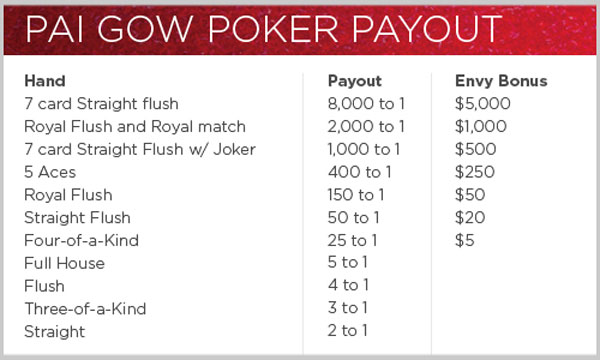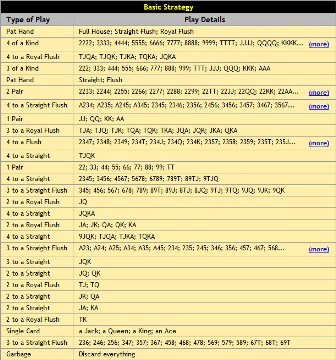Pai-Gow poker--also known as double-hand poker--was invented in the 1980s, but its roots stretch back much further. That's because the game takes inspiration from the popular Chinese domino game known as pai gow, which came into being sometime around 960 AD.
The purpose of this article is to familiarize you with the basics of the game, from the rules of pai gow poker to various forms of real-money strategy. While the house will always maintain an edge over the player, an increased knowledge of the game should give you the best odds of walking away with a profit.
The Joker in Pai-Gow Poker
Except as otherwise provided in the Lottery Game Rules or the Pay-to-Play Game Rules, no claim or dispute by a Player with regard to any bet, wager or purchase of a Game, including the outcome of such Game, will be considered by OLG (i) in the case of a Draw-Based Lottery Game Played Online, more than 12 months following the date on which the. The lower your Pai Gow, the higher your payoff if you make that bet. You may also find other side bets. Check the table before you play. Banking in Pai Gow Poker. One way to gain and advantage in Pai Gow is to bank whenever you have the opportunity to do so. Ask the dealer how and when you may bank.
In addition to the usual 52 cards, the deck used in pai-gow poker also includes a single joker. The joker may substitute for any card in order to complete a straight, flush, or straight flush. Otherwise, it counts as an ace.
Pai-Gow Hand Rankings
While most of the rankings in double-hand poker are the same as regular poker, there are a few minor differences.
Five of a Kind - The highest possible pai gow poker hand, it's comprised of four aces and a joker.
Royal Flush - Made up of the following cards in the same suit: A, K, Q, J, 10.
Straight Flush - Five cards of the same suit in consecutive order. Example: 6H, 7H, 8H, 9H, 10H.
Four of a Kind - Four cards made up of the same rank. For example: 7H, 7D, 7C, 7S.
Full House - A hand comprised of one pair and three of a kind. Example: 4H, 4D, 4S, 6S, 6H.
Flush - Five cards made up of the same suit. Example: 2H, 4H, 5H, 8H, 10H.
Straight - Five consecutive cards of different suits. Example: 7H, 8S, 9C, 10C, JD.
Three of a Kind - Three cards of the same rank. Example: 2S, 2D, 2H.
Two Pair - Two individual pairs, each made up of a different rank. Example: 4C, 4D, 9H, 9C.
One Pair - Two cards of the same rank. Example: 4S, 4D.
High Card - When the hand contains none of the above combinations, the highest card is used to determine the hand's value.
How to Play Pai-Gow Poker for Real Money
Now that we've looked at the purpose of the joker and the hand rankings, let's examine the specific rules of pai-gow poker. Keep in mind that the player is competing only against the dealer.

The game begins when the player makes a wager. Betting requirements differ from one casino to another, so make sure you check before starting play.
After the player has made their bet, they will be provided with seven cards. The dealer also receives seven cards face-down.
The player examines his hand and separates it into a five-card ('high') and two-card ('low') hand. The five-card option must be superior to the two-card hand (see the hand rankings listed above). The two-card hand can only achieve a pair or high card ranking.
Once the player has set his hand, the dealer turns his cards over and also arranges them into 5-card and 2-card sets. In both land-based and online casinos, the house has specific rules for how this is done, which prevents the dealer from having to employ any kind of strategy. This is known as the 'house way.'
The hands are now compared against one another. Here are the results:

- If both the player's hands are superior, he is declared the winner and receives even money on his payout, minus a 5% commission.
- If the player and dealer each win a hand, then the bet is considered a push.
- If the dealer wins both hands, the player loses his bet. Please note that a dealer wins any ties.
Pai Gow Poker Banking Rules For Beginners
Hand Odds in Pai-Gow Poker
The following list shows the probability of achieving various hands in a game of double-hand poker.
- Five Aces - 0.00000732
- Royal Flush/Straight - 0.00136862
- Four of a Kind - 0.00199472
- Full House - 0.02717299
- Flush - 0.04004129
- Straight - 0.07289350
- Three of a Kind - 0.04846585
- Two Pair - 0.23065464
- One Pair - 0.41663862
- Anything Else - 0.16076246
Winning Strategies for Real-Money Pai-Gow Poker
If you're looking for an edge during your next pai gow poker session, give these tips a try. While you may still lose some hands, you should see your overall success rate improve.

The game begins when the player makes a wager. Betting requirements differ from one casino to another, so make sure you check before starting play.
After the player has made their bet, they will be provided with seven cards. The dealer also receives seven cards face-down.
The player examines his hand and separates it into a five-card ('high') and two-card ('low') hand. The five-card option must be superior to the two-card hand (see the hand rankings listed above). The two-card hand can only achieve a pair or high card ranking.
Once the player has set his hand, the dealer turns his cards over and also arranges them into 5-card and 2-card sets. In both land-based and online casinos, the house has specific rules for how this is done, which prevents the dealer from having to employ any kind of strategy. This is known as the 'house way.'
The hands are now compared against one another. Here are the results:
- If both the player's hands are superior, he is declared the winner and receives even money on his payout, minus a 5% commission.
- If the player and dealer each win a hand, then the bet is considered a push.
- If the dealer wins both hands, the player loses his bet. Please note that a dealer wins any ties.
Pai Gow Poker Banking Rules For Beginners
Hand Odds in Pai-Gow Poker
The following list shows the probability of achieving various hands in a game of double-hand poker.
- Five Aces - 0.00000732
- Royal Flush/Straight - 0.00136862
- Four of a Kind - 0.00199472
- Full House - 0.02717299
- Flush - 0.04004129
- Straight - 0.07289350
- Three of a Kind - 0.04846585
- Two Pair - 0.23065464
- One Pair - 0.41663862
- Anything Else - 0.16076246
Winning Strategies for Real-Money Pai-Gow Poker
If you're looking for an edge during your next pai gow poker session, give these tips a try. While you may still lose some hands, you should see your overall success rate improve.
- Avoid Bonus Bets - These side bets are far more common at land-based casinos, but even if you find an online establishment that offers them, they are to be avoided. Casinos take in more money from bonus bets than they do from the 5% commission charged to winning player hands.
- If you're lucky enough to get five aces, you should keep three in the high hand and move the others to the low hand. The only exception is when you have a pair of kings. In this case, move the kings to the low hand.
- When you have four of a kind, the following strategy should be employed. Keep the four cards together if their ranks are six or lower. If the ranks are seven through 10, split the cards unless you also have an ace or better to move to the low hand. Unless you have another pair to use in the low hand, four of a kind with face cards should always be split.
- Three of a kind should almost always be kept together. The only exception is when the cards are aces. In this case, use a pair of aces in the high hand and the remaining ace (along with your next highest card) in the low hand.
- If you have three pair after the initial deal, the highest pair should be moved to the low hand.
- If you find yourself with no pairs, flushes, or straights, leave the best card in the high hand and move the two cards with the next highest value to the low hand.
- When you draw a full house, move the pair to the low hand. If you happen to draw an additional pair, then use the higher of the pairs for the low hand.
- It is best to keep straights and flushes in the high hand. If, however, you have a pair of tens or better and an ace/king to move to the low hand, then you might consider splitting up a flush or straight.
- If you have two pair, and one of the pairs is comprised of aces, then you should split. The same goes for two pair with a pair of kings (unless the other is a pair of deuces). If the latter occurs, play the pairs together in the high hand and move the next best cards to the low hand.
- If you have two pair with jacks though aces, split the pairs and leave the best one in the high hand.
Pai Gow Poker is a casino table game and is played with a standard 52-card deck plus one joker. The rules are fairly simple. After making a bet, each player is dealt seven cards and must make two poker hands: A standard five-card poker hand and a two-card poker hand. The five-card hand is often called 'behind', or the 'bottom,' 'high,' or 'big' hand, while the two-card hand is called 'in front', 'on top', or the 'small,' 'minor,' or 'low' hand.
When forming your two hands from your seven cards, the five card hand must be higher than the two-card hand. In other words, if you are dealt A-A-3-5-7-10-J and you can‘t make a flush, you must include the pair of aces in the five-card poker hand, not the two-card poker hand.
Five-card hands follow the standard what-beats-what rules, with two exceptions: some casinos count A-2-3-4-5 as the second-highest straight. This is the case in some places in Nevada. Additionally, having a joker in the deck introduces the possibility of five of a kind which beats a straight flush.
The best two-card hands are pairs and then simply high cards. Straights and flushes don't matter in the two-card hand. The worst possible 2-card hand is 2-3, while the best is a pair of aces.
Pai Gow Poker Banking Rules And Regulations
The Joker in Pai Gow Poker
Instead of acting as a whatever-card-you-want wild card, the joker in Pai Gow is called a 'bug.' It acts as an ace unless it can be used to fill out a straight or a flush. This also means that you can have five aces, which is the best possible five-card hand in Pai Gow.
Showdown
Once players have set their two poker hands, they place their hands in front of them, the two-card hand in front, and the five-card in the back (hence those nicknames). All the players at the table are playing to win both hands against the 'banker.' The banker can be the dealer, or one of the players at the table, like in Baccarat.
Determining Who Wins
Each player compares his hands to the banker's hands. If both the player's hands beat the banker's, the player wins. If one of the player's hands beats the banker's hands but not the other, it's considered a push or draw and the player takes back his money. If the banker's hands beat the player's, the player loses. In the case of a tie, the banker wins. Double black jack daniels price. This is one of the ways the house keeps the advantage. If a player is banking, the house takes a commission from the winning hands and doesn't need an advantage.